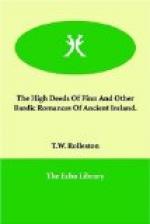As to the poetry of Ireland, that other Art which is illustrated in this book, so fully has it been dwelt on by many scholars and critics that it needs not be touched here other than lightly and briefly. The honour and dignity of the art of poetry goes back in Irish mythology to a dim antiquity. The ancient myth said that the nine hazels of wisdom grew round a deep spring beneath the sea, and the hazels were the hazels of inspiration and of poetry—so early in Ireland were inspiration and poetry made identical with wisdom. Seven streams of wisdom flowed from that fountain-head, and when they had fed the world returned to it again. And all the art-makers of mankind, and of all arts, have drunk of their waters. Five salmon in the spring ate of the hazel nuts, and some haunted the rivers of Ireland; and whosoever, like Finn, tasted the flesh of these immortal fish, was possessed of the wisdom which is inspiration and poetry. Such was the ancient Irish conception of the art of poetry.
It is always an art which grows slowly into any excellence, and it needs for such growth a quieter life than the Irish lived for many centuries. Poems appear but rarely in the mythological or heroic cycles, and are loosely scattered among the prose of the bardic tales. A few are of war, but they are chiefly dirges like the Song of Emer over the dead body of Cuchulain, or that of Deirdre over Naisi—pathetic wailings for lost love. There is an abrupt and pitiful pain in the brief songs of Fionnuala, but I fancy these were made and inserted in Christian times. Poetry was more at home among the Fianna. The conditions of life were easier; there was more leisure and more romance. And the other arts, which stimulate poetry, were more widely practised than in the earlier ages. Finn’s Song to May, here translated, is of a good type, frank and observant, with a fresh air in it, and a fresh pleasure in its writing. I have no doubt that at this time began the lyric poetry of Ireland, and it reached, under Christian influences, a level of good, I can scarcely say excellent, work, at a time when no other lyrical poetry in any vernacular existed in Europe or the Islands. It was religious, mystic, and chiefly pathetic—prayers, hymns, dirges, regrets in exile, occasional stories of the saints whose legendary acts were mixed with pagan elements, and most of these were adorned with illustrations drawn from natural beauty or from the doings of birds and beasts—a great affection for whom is prominent in the Celtic nature. The Irish poets sent this lyric impulse into Iceland, Wales, and Scotland, and from Scotland into England; and the rise of English vernacular poetry instead of Latin in the seventh and eighth centuries is due to the impulse given by the Irish monasteries at Whitby and elsewhere in Northumbria. The first rude lyric songs of Caedmon were probably modelled on the hymns of Colman.




